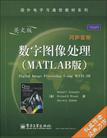数字图像处理
2009-12
电子工业出版社
(美)冈萨雷斯 等著
609
无
Solutions to problems in the field of digital image processing generally requireextensive experimental work involving software simulation and testing with large setsof sample images Although algorithm development typically is based on theoreticalunderpinnings, the actual implementation of these algorithms almost always requiresparameter estimation and, frequently, algorithm revision and comparison of candidatesolutions. Thus, selection of a flexible, comprehensive, and well-documented softwaredevelopment environment is a key factor that has important implications in the cost,development time, and portability of image processing solutions In spite of its importance, surprisingly little has been written on this aspect of thefield in the form of textbook material dealing with both theoretical principles and soft-ware implementation of digital image processing concepts. This book was written forjust this purpose. Its main objective is to provide a foundation for implementing imageprocessing algorithms using modem software tools.A complementary objective was toprepare a book that is self-contained and easily readable by individuals with a basicbackground in digital image processing, mathematical analysis, and computer pro-gramming, all at a level typical of that found in a junior/senior curriculum in a techni-cal discipline. Rudimentary knowledge of MATLAB also is desirable. To achieve these objectives, we felt that two key ingredients were needed. Thefirst was to select image processing material that is representative of material cov-ered in a formal course of instruction in this field. The second was to select soft-ware tools that are well supported and documented, and which have a wide rangeof applications in the "real" world. To meet the first objective, most of the theoretical concepts in the following chapterswere selected from Digital Image Processing by Gonzalez and Woods, which has beenthe choice introductory textbook used by educators all over the world for over twodecadesThe software tools selected are from the MATLAB Image ProcessingToolbox(IPT), which similarly occupies a position of eminence in both education and industrialapplications A basic strategy followed in the preparation of the book was to provide aseamless integration of well-established theoretical concepts and their implementationusing state-of-the-art software tools The book is organized along the same lines as Digital Image Processing. In this way,the reader has easy access to a more detailed treatment of all the image processingconcepts discussed here, as well as an up-to-date set of references for further reading.Following this approach made it possible to present theoretical material in a succinctmanner and thus we were able to maintain a focus on the software implementation as-pects of image processing problem solutions Because it works in the MATLAB com-puting environment, the Image Processing Toolbox offers some significant advantages,not only in the breadth of its computational tools, but also because it is supportedunder most operating systems in use today.
本书是图像处理理论与以MATLAB为主要工具的软件实践方法相结合的第一本书。特色在于重点强调如何通过开发新代码来加强软件工具。介绍MATLAB编程基础知识之后,讲述了图像处理的主干内容,包括灰度变换、线性和非线性空间滤波、频率域滤波、图像恢复与配准、彩色图像处理、小波、图像数据压缩、形态学图像处理、图像分割、区域和边界表示与描述,以及目标识别。 本书可供从事信号与信息处理、汁算机科学与技术、通信工程、地球物理等专业的大专院校师生学习参考。
作者:(美国)冈萨雷斯(Rafael C.Gonzalez) (美国)Richard E.Woods (美国)Steven L.Eddins
1 Introduction Preview 1.1 Background 1.2 What Is Digital Image Processing? 1.3 Background on MATLAB and the Image Processing Toolbox 1.4 Areas of Image Processing Covered in the Book 1.5 The Book Web Site 1.6 Notation 1.7 The MATLAB Working Environment 1.8 How References Are Organized in the Book Summary 2 Fundamentals Preview 2.1 Digital Image Representation 2.2 Reading Images 2.3 Displaying Images 2.4 Writing Images 2.5 Data Classes 2.6 Image Types 2.7 Converting between Data Classes and Image Types 2.8 Array Indexing 2.9 Some Important Standard Arrays 2.10 Introduction to M-Function Programming Summary3 Intensity Transformations and Spatial Filtering4 Frequency Domain Processing5 Image Restoration6 Color Image Processing7 Wavelets8 Image Compression9 Morphological Image Processing10 Image Segmentation11 Representation and Dexcription12 Object RecognitionAppendix A Function SummaryAppendix B ICE and MATLAB Graphical User InterfacesAppendix C M-FunctionsBibliographyIndex
插图:Another way to obtain help for a specific function is by typing doe followedby the function name at the command prompt. For example, typing doe f o r matdisplays documentation for the function called format in the display pane ofthe Help Browser. This command opens the browser if it is not already open. M-functions have two types of information that can be displayed by theuser. The first is called the H1 line, which contains the function name and aone-line description. The second is a block of explanation called the Help textblock (these are discussed in detail in Section 2.10.1). Typing help at theprompt followed by a function name displays both the H1 line and the Helptext for that function in the Command Window. Occasionally, this informationcan be more up to date than the information in the Help browser because it isextracted directly from the documentation of the M-function in question. Typ-ing lookfor followed by a keyword displays all the H1 lines that contain thatkeyword. This function is useful when looking for a particular topic withoutknowing the names of applicable functions. For example, typing look for edgeat the prompt displays all the H1 lines containing that keyword. Because theH1 line contains the function name, it then becomes possible to look at specif-ic functions using the other help methods. Typing lookfor edge -all at theprompt displays the H1 line of all functions that contain the word edge in ei-ther the H1 line or the Help text block.Words that contain the characters edgealso are detected. For example, the H1 line of a function containing the wordpolyedge in the H1 line or Help text would also be displayed.
《数字图像处理(MATLAB版)(英文版)》由电子工业出版社出版。

无
数字图像处理(MATLAB版)(英文版)非常精彩,无法形容的精彩。
对图像处理和matlab的处理很有用,可以做讲点教材使用。
和数字图像处理是配套的,很好用
很好的图像处理书籍,经典
这本书很好,英文版的许多地方理解上比中文翻译版的要好很多
以前买了本中文的由于英语学习需要,股买了本英文版的对照着看.
英文版,据说比中文版好的多
看这种书,就得看英文版的,慢慢看还是很有心得的。
英文写作地道,买了学习英语
还不错,刚刚拿到,大概内容都会
考博必备经典教材,多学有用
I ***e this book very much,it is a successful work!My mum also ***e it too.
很棒~就是需要的~
英文原版很全面到位
挺好的 是我们上课老师推荐的课本
如题,啥都不说了,就是送过来感觉有点破
不错我真觉得这挺好的
还是老外的书来得严谨。此书经典到爆啊
好好好,还没看 好好好,还没看
还是读英文原版的好,中文的翻译有的时候会有问题
不错,价格还是便宜,折上折的,本来就是经典教程,有时间啃啃吧
还是原版纯正
冈萨雷斯的经典,顶
非常好,你不错的选择
朋友推荐的,感觉正是我需要的。
这本书更确切的说应该是MATLAB图像处理,讲MATLAB的比图像处理要多。遗憾的是不带源码。
书还没读,但搞图像的都知道,这是必备品
不错,英文版要多下功夫看看
这本书的内容确实不错,不过纸张太差了吧,里面的图片印刷质量真差,不会是盗版的吧?
书的内容很好,学习起来也不是很难
好书但却不一定适用,如果是实用主义,想拿来就用,不如换本其他的,如果想了解这一领域,建议这本书,详细,全面
书基本上是按要求上发送的,基本没有问题。
老外的书讲的详细,不过英语得好啊
速度给力啊,上课要用的,还要英文的。。。
质量很好,纸张不错,很经典的一本教材,学校用作教科书,用起来很好。
帮小师弟买的,应该还行吧
书还没看。感觉不错
以为是理论和试验,结果发现是调用MATLAB函数库
工具性太强,不做课后习题的可以不用买,但写得还行
和同学一起买了三套书,本以为会很好。收到发现书明显感觉不是正版的。英文版里面Preface竟然是中文写的,而且没有彩页图片,和同学中文版的对比了一下,差距甚远。而且书有褶皱让人感觉比较旧。
对照了Amazon与当当的价格,发现当当便宜5块钱,可今天拿到书才知道非正版,没有激光防伪标志且翻开后偶尔能发现印刷小斑点,郁闷。虽然你便宜,但若不是正版也得说明一下才行啊。
书的质量一般,看着不像正版的
appendix B以及appendix C部分有几页的印刷有严重问题,字迹有明显的阴影,根本看不清印的是什么东西,如果不是嫌麻烦,真想换一本,影响心情啊。。。。。。上面的一分是打给书本质量的,不是书的内容。。。。。
第二版是09年出的,现在已经是2011年了,第一版就收起来吧,要与时俱进。
我只能说西安库发出来的这个太像盗版了
专业需要的书籍,很不错
边学英语变学知识,一举两得
拿到这本书很失望,书很软,纸很薄,很像盗版,并且还没有激光防伪标志的。 估计是盗版书~
这门书一再的再版,逐渐其畅销性和与时俱进性,既经典又新颖。
看了100多面了。和我们老师在市面上买的尺寸不一样,小了很多。字印的还行,就是有几页纸还有有纹路。感觉是网上专供的。而且到国外官网上一看,这书的资料已经下架了,因为都出第二版了。然后去代理商的网站,也没有书中自创的M文件,源图片,课件的下载。总之失望了
纸张很差 和我原来买的那本非matlab版纸张差多了 里面的图片也没有那本非matlab版的清晰
一直听别人介绍不错,这次买了下,觉得看了以后很受益,而且里面的程序很精简,对于提高自己的matlab编程很有好处
根据我对比亚马逊总站的介绍,黑底的这个是第一版的,第二版的是白色的底。
大牛写的
买错了,我要买中文版的